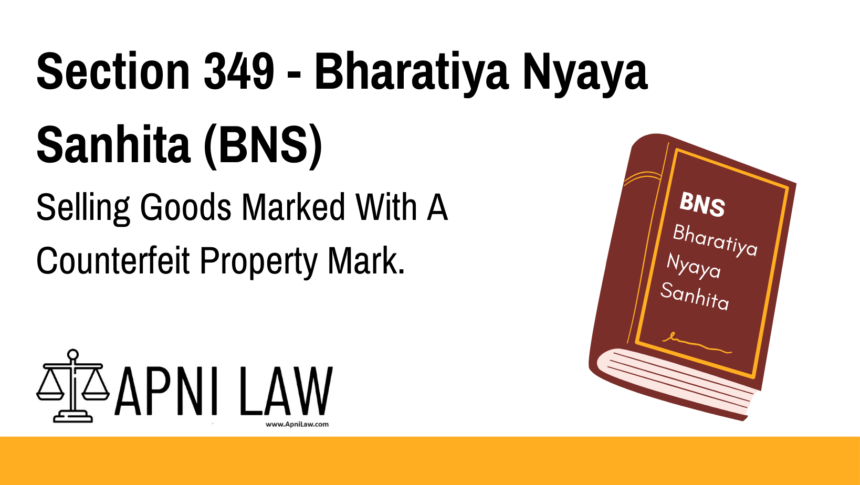Code: Section 349 BNS
Whoever sells, or exposes, or has in possession for sale, any goods or things
with a counterfeit property mark affixed to or impressed upon the same or to or upon any
case, package or other receptacle in which such goods are contained, shall, unless he proves—
(a) that, having taken all reasonable precautions against committing an offence
against this section, he had at the time of the commission of the alleged offence no
reason to suspect the genuineness of the mark; and
(b) that, on demand made by or on behalf of the prosecutor, he gave all the
information in his power with respect to the persons from whom he obtained such
goods or things; or
(c) that otherwise he had acted innocently,
be punished with imprisonment of either description for a term which may extend to one year,
or with fine, or with both.
Explanation of Section 349 BNS
Section 349 of the Bharatiya Nyaya Sanhita (BNS) addresses the sale of goods marked with counterfeit property marks. This section is designed to protect businesses, consumers, and the integrity of commercial transactions from deceptive practices.
Key Aspects:
- Offense:
- Selling, exposing, or possessing for sale any goods that bear a counterfeit property mark.
- This applies to goods directly or indirectly associated with the mark (like packaging).
- Exceptions (Burden of Proof on the Accused):
- The accused can avoid punishment if they can prove:
- (a) They took reasonable precautions and had no reason to suspect the mark was counterfeit.
- (b) They provided all relevant information about the source of the goods when requested.
- (c) They acted innocently, without intent to deceive.
- The accused can avoid punishment if they can prove:
- Punishment:
- Imprisonment up to 1 year, a fine, or both.
The section emphasizes due diligence in commercial activities and places the burden of proof on the seller to demonstrate innocence if accused.
Illustration
Example 1: Selling Counterfeit Branded Goods
A retailer sells bags marked with a famous luxury brand’s logo, but the logo is counterfeit. If the retailer can’t prove they took reasonable precautions or didn’t suspect the mark was fake, they could be punished under Section 349.
Example 2: Innocent Seller of Fake Goods
A local vendor buys electronic items from a wholesaler, unaware that the items have counterfeit certification marks. If the vendor provides information about the wholesaler and proves they acted innocently, they may avoid punishment.
Common Questions and Answers on Section 349 BNS
1. What qualifies as a counterfeit property mark?
- Answer: Any mark that falsely represents ownership, origin, or quality of goods, intended to deceive consumers or businesses.
2. Can I be punished if I unknowingly sell counterfeit goods?
- Answer: Yes, unless you can prove you took reasonable precautions and had no reason to suspect the mark was counterfeit.
3. What kind of precautions should a seller take?
- Answer: Verifying the authenticity of suppliers, checking for official certifications, and conducting regular audits.
4. How does the burden of proof work in this case?
- Answer: The accused must prove their innocence, showing they acted without fraudulent intent or negligence.
Conclusion
Section 349 of the Bharatiya Nyaya Sanhita (BNS) is a critical provision for maintaining fairness and honesty in trade and commerce. It not only penalizes those who knowingly sell counterfeit goods but also provides a fair opportunity for innocent sellers to defend themselves.








